samedi, 15 février 2020
Oswald Spengler and the Morphology of Cultures
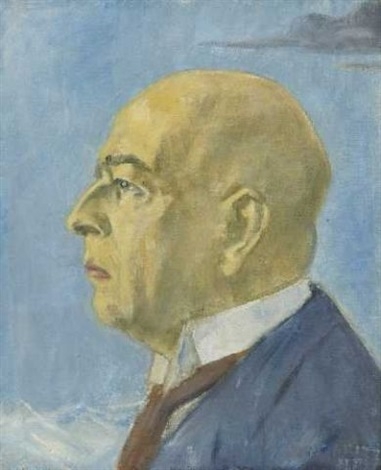
Oswald Spengler and the Morphology of Cultures
Arthur Chandler
Ex: http://www.arthurchandler.com
(originally printed in Humanities, 1978)
Morphology: “the study of the form and structure of organisms and their specific structural features” (Wikipedia)
Prelude
Under the gloom of the funeral day, adult hands persuade the child to the pews. The minister intones the solemn ceremony, while grown-up faces weep, or press their sadness between steady eyes and firm lips. The child feels the strange oppressiveness of the atmosphere, but as yet cannot fathom the reason.
Then the final processional: grim men and women file by the casket. The father’s hands reach down and lift the child high: and there, hovering like a captive angel in his father’s grip, the child first sees the shell of his grandfather’s soul. He stares down at the face he knew last week: the same face, but now shrunken into something remote and unfamiliar. It’s not like grandfather sleeping: something is gone.
“The child suddenly grasps the lifeless corpse for what it is: something that has become wholly matter, wholly space; and at the same moment it feels itself an individual being in an alien and extended world. Here, in the decisive moments of existence, when the child first becomes man and realizes his immense loneliness in the universal, the world-fear reveals itself for the first time as the human fear in the presence of death.”
Later, back in the subdued warmth of his own home, the child gazes out the window. People walk, cats prowl, birds dart. All live — but not grandfather. He will never walk the earth again. Never.
The day completes its cycle. Distinctions blur in the landscape. Stars wink into sight — tiny brightnesses in a vast dark. People lie down to sleep. Some people, like grandfather, will never see the morning: this the child now knows with certitude.
The tears well up and shatter down his cheeks. He cries not only for the loss of what grandfather was for him: he cries for the inescapable loneliness that the sureness of grandfather’s death now means.
In these moments, the soul of the culture, like the soul of the child, is born.
First Act: The Birth of the Soul of the Culture
“Primeval man is a ranging animal, a being whose waking consciousness restlessly feels its way through life, under no servitude of place or home, keen and anxious in its senses, ever alert to drive off some element of hostile Nature. A deep transformation sets in at first with agriculture — for that is something artificial, with which the hunter and shepherd have no touch. He who digs and plows is seeking not to plunder, but to alter nature. To plant implies, not to take something, but to produce something. Man roots in the earth that he tends, the soul of man discovers a soul in the countryside, and a new earth-boundness of being, a new feeling, pronounces itself. Hostile Nature becomes the friend, earth becomes Mother Earth. Between sowing and begetting, harvest and death, the child and the grain, a profound affinity is set up.”
People in landscape — this is the one fundamental, the basic unity of life and place that accompanies the birth of every culture. And from the shared unity of experience of the landscape comes the Culture: that totality of traditions and institutions that marks the expansion of a people’s existence into an organic unity greater than the sum of the individual lives that compose it.
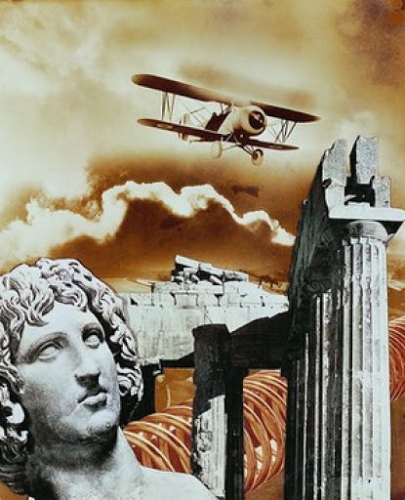
The local earth and air surround them. The new-born are delivered into a regional Nature that envelops them with its special shape of hills, demands of the soil, felt rhythm of the seasons, and sublime procession of the heavens at night. The old are finally delivered into the earth, or scattered to the winds — back to the mother-landscape. All life between infancy and death becomes a participation in the greater life of the Culture itself.
In every culture, attitudes toward the surrounding world coalesce, and shape themselves, in their highest mode of expression, as religion. In the springtime of a society, the myth of a people expresses for them what the world is and means, why it is fashioned thus, and what they must do in obedience to the Ordering Principle. It is here, in the forms and assumptions of each religion, where cultural axioms reside.
Most of the countless human societies that come into being never become civilizations. With a very few Cultures, however, a new form of growth cycle begins. The first herald of this beginning is the birth of the soul of a town. “This is a mass-soul of a wholly new kind, which suddenly buds off from the general spirituality of its Culture. As soon as it awakes, it forms for itself a visible body. Out of the rustic group of farms and cottages, each of which has its own history, arises a totality. And the whole lives, breathes, grows, and acquires a face and an inner form and history.” When this budding culture metamorphoses into a civilization, the fateful and fated cycle has begun. Thenceforward the style-history of the Culture ever more resides in the town, the city, and finally in the gigantic megalopolis.
The Prime Symbol
As the town grows in the passage of time, the grand religious myths of its beginnings take on a style — those recognizable traits that separate each culture from all others — and mark the limits and possibilities of its soul. “Style itself is the rhythm of the process of self-implementing.” And it is the style that tells us that a building is Roman and not Renaissance, that a proof of a theorem belongs to Desargues and not Euclid, that a bas-relief is Assyrian and not Sumerian.
As an individual, everyone enacts a personal style of gesture, inflection, habit. The overall rhythm is given to us by the Culture, but its inflections are our own. Just so, people build and paint and create mathematics. Every architect, every artist, every mathematician shows forth in their work a style: unique personal inflections on the overarching rhythms of tradition. The unity of that cultural rhythm, the basic bond that integrates all branches of a culture into a pervasive whole, is its Prime Symbol. This symbol exists in every phase of a culture’s life, no matter how apparently grand or modest. But in its highest modes of creativity — in art, thought, political action and above all in religion, that the Prime Symbol is expressed with greatest purity and force.
“All that is, symbolizes.” In the great cultures — those entities that are destined to unfold into civilizations — world-fear and world-longing find expression in their Prime Symbols, which set the limits and define the possiblities of their growth and the secret of their inner principle of decay.
For Faustian Civilization — the outcome of the Culture of Western Europe and its siblings — the matrix of all reality, the core of its Prime Symbol, is infinite space.
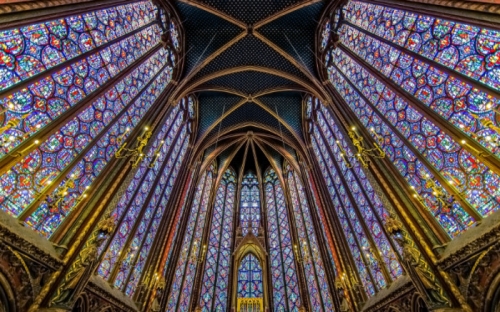
The Gothic Cathedral’s spires and arches yearn upward for the infinite, just as its space-commanding giant of sound, the bellows organ, storms heaven with its counterpoint of expanding volume. In Faustian painting, the ever-present and unifying device of perspective commands the eye to follow out to the vanishing point at infinity. In the realm of mathematics — where cultures show their beliefs about reality in purest form — Western mathematicians posit an infinitely extensive and infinitesimally divisible grid of space-points which radiate out to infinity in three dimension — and later, in an infinite number of directions.
For the classical culture of Greece, the Prime Symbol was radically different — and so, too, was the form-ideal is sought to express in its arts and thought. For the people of classical civilization, the near and present bodily form of things made up the basis, the ἀρχή, of existence. Greek painting contains no ordered distances, only bodies. Euclidean geometry always gives us the mathematics of surface and volume, never point-systems of variables in a matrix of infinite, Cartesian space. Even the music of Greece, with its supposed harmonic connection with Western music, is in fact based on a sound-appreciation of a radically different sort. For the classical mind, harmony consists of the relationship of two sounded notes. To the Western sensibility, music consists of the ever-changing relationship among moving intervals — mobile spaces between note clusters — that provides the sense of sonic dynamism.
The Western/Faustian mind perceives the universe as infinite space: the Classical/Apollonian as well-ordered aggregates of bodily forms beneath a corporeal vault of the heavens. A third civilization — the Near-Eastern/Magian — conceives of the universe as a cavern. Here, the primordial light-versus-dark struggle pervades the cavern dome of the heavens even as it dominates the eternal wars among the human race. The Magian world is thus a cosmos of opposing substances: God versus the devil, the righteous versus the infidel. “Even death, for the author of the John Gospel, as for the strict Moslem, is not the end of life, but a Something, a death force that contends with the life-force for the possession of man.”
By setting the high cultural achievements of the Magian world alongside those of the Apollonian and Faustian, we perceive the radical dissimilarity among them. The classical temple is an architectural body of ordered elements, optically graspable in a single glance, designed as a completely exterior experience for the eye. The Western cathedral is an expression of an inward yearning for the light from infinity. The Near-Eastern mosque is a cavern from which the symbolic duality of light and dark contend in the enclosing dome.
In Classical mathematics, proportions among magnitudes comprise the entirety of number-thought. In the West, it is the relationships among varying functions operating in infinite space that make up the concept of number. In Arabian mathematics, is the “alchemical” transmutation of undefined qualities that pervades the essence of mathematics. “And as Euclidean geometry is to Attic statuary (the same expression-form in a different medium) and the analysis of space to polyphonic music, so is algebra to the Magian art of the gold mosaic and the arabesque.”
Infinite space, the cavern cosmos, the sum of the forms of bodies — these are the essential cultural axioms of three of the great civilizations that have actualized their Prime Symbols. To the historical imagination searching for the morphology of other cultures, other Prime Symbols can be discovered:
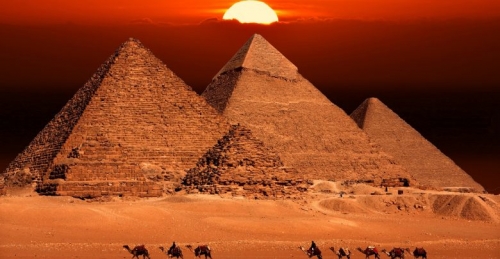
For the Egyptian, reality was “a resolute march down the path once entered.” The pyramids, seen in this light, are not buildings in the Western sense but pathways enclosed by mighty masonry.
“For the Chinese, the world-around is approached as a hither-and-thither wandering that nevertheless goes to the goal.” It is The Way: and in a culture where the path through Nature becomes the highest and deepest form of sensibility, landscape gardening becomes a high art, comparable in its richness and philosophical depth to the Gothic Notre Dame, the Magian Blue Mosque, and the Parthenon.
For the soul of India, the world is illusion, an existential zero, and its goal, the ever-circling phantom show of creation and destruction, to be escaped by attaining Nirvana. Here, the Prime Symbol is Zero — an idea which, in the realm of numbers, meant something entirely different to traditional Indian mathematicians than to their Faustian counterparts, for whom the 0 has always entailed deep paradoxes.
Interlude
The Child attains maturity. In the course of life, the growing youth encounters heroes and villains, profound thinkers and shallow phrased-spinners, firm friends and sly enemies. From all these people, real and fictional, we learn — but they do not influence us. We choose what we will take, and what we will ignore. Tough we expand and deepen our outlook throughout life, it is a deepening and expansion of our own nature. All outside forces are converted by our minds and bodies to our own uses. Those forces do not influence us: we pick and choose among them.
We see a painting, hear a symphony, read a sonnet. In doing so, we “experience something in ourselves, but cannot give any account of the relation between this experience and what the creators lived in themselves. We see a form, but we do not know what in the other’s soul begat that form: we can only have some belief about the matter, and we believe by putting in our own soul. However definitely and distinctly a religion may express itself in words, they are words, and we put our own sense into them. However impressive the artist’s notes to colors, he sees and hears in them only ourselves, and if we cannot do so, the work is for us meaningless.”
Just so, the relationships between Cultures: connotations are not transferrable.
The Integrity of the Prime Symbol
Once a culture’s own Prime Symbol is established and expressed, its essence is unalterable. Individual works, or whole expression-forms such as Attic drama or Arabian alchemy, can be studied by Western dramatists or scientists. But outside their culture of origin, such works are lifeless. They have no power within themselves to move people of another origin. The choice to use this or that element must be made; and at that point, the user, not the work, dictates the nature to which the plot or formula will be put.

Furthermore, most alien works are never “borrowed” at all. “In all conventional history, it is only the relations that are accepted that we observe. But what of those that were not accepted? Why, for example, do we fail to find in Classical expression-forms — supposedly “influenced” by Egypt — the pyramid, pylon, obelisk, hieroglyphic? What of the stock of Byzantium and of the Moorish East was not accepted by Gothic art and thought in Spain and Sicily?”
“Consider how every living Culture is continuously bathed in innumerable potential influences. But out of these, only some few are admitted as such — the great majority are not. Is the choice, then, concerned with the works, or with those creators who choose or ignore them?”
In the end, nothing reaches maturity except through the fulfillment of its own nature. Each Culture transvalues all its borrowings and makes them its own. Denotations may be taken, but connotations are inevitably transformed. The Prime Symbol, the Culture’s basic attitude toward its environment, translates all influences, expands, grows deeper and richer thereby, but remains in its essence inviolable.
Finale
Children become men and women, marry, and beget their own children. In them and through them, the parents seem to be reborn, surrounding their offspring with affection, knowledge and moral lessons condensed from life. But for all the parents’ efforts, children still go their own ways, absorbing, rejecting, and recreating themselves with all that their environment offers them. The child is the father and mother of the adult.
And so the child grows old, following the unalterable decay endemic to all creatures born and moving through time. Early creativity stiffens into pattern and habit. The fire in the blood cools, leaving noble the lukewarm pleasures of the philosophic mind, or a death-driven flight into a second religiousness.
But even in the winter years, there are tasks to perform. Twilight and winter leave bare the shape of things: the darkening mountain, the leafless tree, the multicolored past stripped to its essential components and toned down by the blank certitude of impending death. Still the world-fear and world-longing are at work, even in the deficient veins of the old; and if accident and senility can be avoided, the prime feelings of meaning in the world may yet produce final, austere monuments as departing symbols of a mature mind drawing to a close.
And then, the only end of age.
The Last Task
Some civilizations, like the Egyptian and the Indian, prolong their final years into centuries. In extended crepuscule of long-lived civilizations, the main creative works had long since been accomplished, and only a diminished echo of earlier greatness lingered in art and thought.
In some instances, late megalopolitans yearn and clamor for barbarian vigor, and turn aside from their own spiritual sources in an attempt to rediscover meaning in borrowed forms. This second religiousness sprouts like mushroom clusters on the great sitting tree of the civilization ion. And though the death of the Culture may be postponed, the decline may not, and must proceed on its destined course to the end.
For Western/Faustian culture, ripe autumn — the period known as the Enlightenment — has concluded. Already with the advent of Romanticism, the yellow softness of decay appears in the arts, and even in science and mathematics. “Impressionism is atheism in colors,” and n-dimensional geometry liberates Western mathematics from the obligation of perfecting the analogy between number and reality. Even the Prime Symbol of infinite space comes under challenge from thinkers who argue for a finite but unbounded universe.
In the sciences, arts, mathematics — in all of the highest orders of Faustian enterprise — the sureness of feel, the universal acceptance of the Prime Symbol of infinite space, has been lost. In all areas, a pervasive skepticism replaces certitude — a skepticism which is, in all cases, the mark of later stages of the Culture’s advance into Civilization. But in the West, this skepticism takes on an especially historical form. Faustian skepticism does not mean, as it did the Apollonian mind, a denial of the possibility of knowledge, nor, as it did for the Magians, a world-weary acceptance of Kismet. Faustian doubt takes the form of acknowledging that different conditions produce different results, that there is no truth that holds true everywhere and in all circumstances. In this connection, it is an occurrence of high cultural significance that Newton’s Laws have given way to Einstein’s theories.
With the loss of the sure feel of tradition, each of us stands at the center of our own conceptual universe and propounds our own unique theory of coherence. For each of us, this theory grows from the roots of Truth as we see it, and puts into practice the principles of action that anyone who aspires to first rank must have. But next to us in the city-scape grows another human-plant, sinking different roots and bearing different fruit. The whole of our era in Faustian civilization is a rich, varied complexity of such exotic growths, each one vying, unsuccessfully, to cover the land, to establish a new Prime Symbol.

Only in the world of technics is the high level of traditional Faustian world-view maintained, and where the Prime Symbol is pursued with something like the intensity of earlier centuries. In the realm of technics, Faustian longing aspires towards its final achievement: the application of power-knowledge for the conquest of astronomical space. “Not this or that bit of the world, as when Prometheus stole fire, but the world itself, complete with its secrets of force, is dragged away as spoil to be built into our culture.”
Religious faith comes at the beginning, practical results at the end. The faith that first sustained Western Culture comes to be superseded by causal, scientific myths which are, nevertheless, still predicated through and through upon the religious foundations at the origin of belief. It is the expansion, refinement, and universal application of technics for the mastery of endless space that constitutes the last and greatest task of Faustian Culture.
“And so the drama of a high Culture — that wondrous world of deities, arts, thoughts, battles, cities — closes with the return of the pristine facts of the blood eternal that is one and the same as the ever-circling cosmic flow. Time triumphs over space, and it is Time whose inexorable movement embeds the ephemeral incident of the Culture, on this planet, in the incident of Man — a form wherein the incident life flows on for a time, while behind it all the streaming horizons of geological stellar histories pile up in the light-world of our eyes.”
In the end, Faustian Culture, like all that lives, must pass away. “Even our machine technics, which seems so imperishable, a contribution to the history of civilization, will end with the Faustian civilization and one day will lie in fragments, forgotten — our railways and steamships as dead as the Roman roads and the Chinese wall, our giant cities and skyscrapers in ruins like old Memphis and Babylon.”
To hope, in fond and vain delusion, for renewed life, or for technics itself to save us from the decline is worse than folly. “Optimism is cowardice.” To recognize the inevitable, and yet perform what our heritage demands of us — this is the highest form of creativity left to us in the final season of our life-course. To face the world-fear of extinction, if not with the confidence of spring then with the determination of age — that is the last task of Faustian technics.
“We are born into this time and must bravely follow the path to the destined end. Our duty is to hold on to the lost position, without hope, without rescue, like that Roman soldier whose bones were found in front of a door in Pompeii, who, during the eruption of Vesuvius, died at his post because they forgot to relieve him. That is greatness. That is what it means to be a thoroughbred. The honorable end is the one thing that cannot be taken from a man.”
All quotations in this essay are from Oswald Spengler’s Decline of the West and Man and Technics, translated by Charles Francis Atkinson.
Backstory to “Oswald Spengler and the Morphology of Cultures”
When I joined the interdisciplinary humanities program at my university, I at once recognized that I needed a unifying structure to unify the various works of literature, the fine arts, philosophy and history that I would be teaching — and, eventually, writing about. I had long been interested in all those fields, plus mathematics, film and photography — but had never thought about them or their interrelationships in any systematic way.
Over a lunch one day, a friend and colleague, David Renaker, suggested that I should look into Spengler’s Decline of the West for just such a unifying overview. I had heard of the book, but assumed it was just another one of the many apocalyptic pronouncements that had been popular in recent decades. But on the strength of David’s recommendation, I bought the book and started reading.
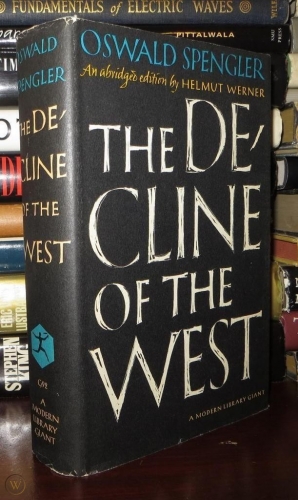 The Decline of the West, I discovered, as neither a traditional history book or a dirge predicting the end of civilization as we know it. Instead, Spengler opened up vast and profound vistas of world cultures, often with startling insights like this:
The Decline of the West, I discovered, as neither a traditional history book or a dirge predicting the end of civilization as we know it. Instead, Spengler opened up vast and profound vistas of world cultures, often with startling insights like this:
"Who amongst [present-day historians] realizes that between the Differential Calculus and the dynastic principle of politics in the age of Louis XIV, between the Classical city-state and the Euclidean geometry, between the space perspective of Western oil painting and the conquest of space by railroad, telephone and long-range weapon, between contrapuntal music and credit economics, there are deep uniformities?" (Spengler, Decline of the West, Volume I, page 7)
The special attraction of the book for me was Spengler’s unusual willingness to see mathematics, not as a system of universal truth, but as yet another creation of each culture, just as much bound to its cultural “Prime Symbol” as its works of literature, art, and religion.
Later, Spengler’s thought served as my inspiration for an essay I wrote for the Western Humanities Review (link here). And though, in the passage of time, I’ve become skeptical of some of his wide-ranging assertions, I still admire the power of his mind and his heroic determination to find unity in the infinite diversity of human history.
00:24 Publié dans Philosophie, Révolution conservatrice | Lien permanent | Commentaires (0) | Tags : allemagne, philosophie, révolution conservatrice, oswald spengler, morphologie des cultures, philosophie de l'histoire |  |
|  del.icio.us |
del.icio.us |  |
|  Digg |
Digg | ![]() Facebook
Facebook



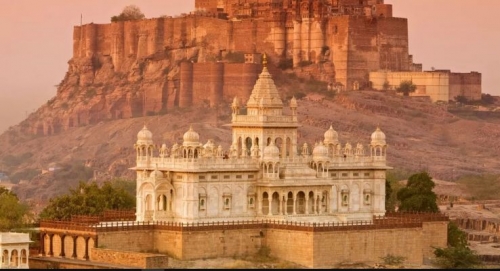
Les commentaires sont fermés.